|
Cover
Story
An Epidemic
Waiting to Happen
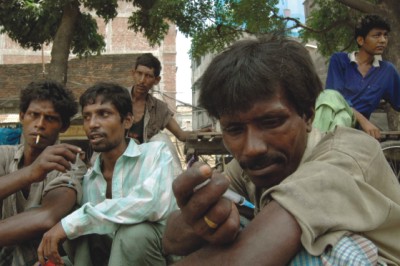 Bangladesh's
HIV/AIDS epidemic is still classified as low level with only
13,000 people living with HIV/AIDS. But experts working on
the issue say the country is on the brink of a nationwide
AIDS crisis. Bangladesh's
HIV/AIDS epidemic is still classified as low level with only
13,000 people living with HIV/AIDS. But experts working on
the issue say the country is on the brink of a nationwide
AIDS crisis.
NAIMUL
HAQ
Many
experts point out that ten years ago India had almost the
same low level status but it now has an uncontrollable epidemic
of HIV/AIDS. The Indian government was initially in denial
regarding the fact that India could have so many people living
with HIV/AIDS.
In
Bangladesh's case several factors, mainly related to the country's
poor socio-economic background, make it an easy target for
an epidemic. These include high rates of sexually transmitted
diseases (STI) among the commercial sex workers, low use of
condom, low level of awareness on prevention of sexually transmitted
disease among the commercial sex workers (CSW), low level
of awareness among the intravenous drug users (IDUs) about
transmission of HIV virus through needle sharing and also
low awareness about HIV transmission among adolescents, the
group most vulnerable.
Social
barriers represent another problem in Bangladesh. Due to religious
and cultural taboos people especially in schools, social meetings
and public gatherings are shy about talking about the risks
of unprotected sex.
Mohammad
Ali, a school teacher in a village of Cox's Bazar district
says, "I did not want to believe HIV infection could
reach our community but since it is hidden and can spread
through anyone who is positive we have to be cautious. I think
it is time for religious leaders to come forward in preventing
the spread of HIV it."
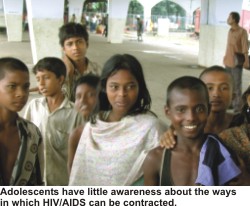 A
local NGO recently trained Ali on awareness of HIV/AIDS and
he has been holding small gatherings in his courtyard to talk
about HIV/AIDS. Likewise, many other religious leaders in
the community have started similar courtyard talks to make
people aware about HIV/AIDS. A
local NGO recently trained Ali on awareness of HIV/AIDS and
he has been holding small gatherings in his courtyard to talk
about HIV/AIDS. Likewise, many other religious leaders in
the community have started similar courtyard talks to make
people aware about HIV/AIDS.
"People
used to feel shy about talking about things like using condom.
But as elderly people have started talking about it no one
seems to feel shy about it anymore," says Ali's fellow
teacher Mazed Khorram.
Drug
users using needles, however, are the most susceptible group.
Not only can they contract the HIV virus through sharing needles,
these individuals often go to sex workers which increase the
risk of the virus spreading. The latest data available from
the sero-surveillance report shows that about four per cent
of the IDUs have HIV infection and it is set to increase or
may even reach epidemic proportion among them, experts point
out.
Initially,
the rate of infection among the IDUs in central Bangladesh
was 1.7 per cent which has now jumped to four per cent and
reaching close to the 'concentrated epidemic' mark of five
percent among the IDUs.
Major
General A S M Motiur Rahman speaking to the Star Weekend Magazine
says, "Bangladesh is still lucky to be low prevalence
with high risk behaviour. In other high risk groups like commercial
sex workers, truckers and professional blood donors the prevalence
of HIV infection is less than one per cent."
Maj.
General Rahman, who is the Chairman of the National AIDS Technical
Committee, however, said that considering the high risk behaviour
there is no reason to believe that the country is safe from
an outburst of HIV infection.
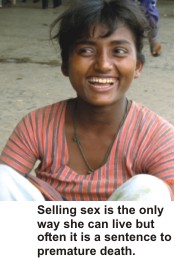 Surveys
of commercial sex workers also shows that although these women
have every intention of using condom and understand the risk
of not protecting themselves, in most cases it was found that
their clients refused to use condoms. Surveys
of commercial sex workers also shows that although these women
have every intention of using condom and understand the risk
of not protecting themselves, in most cases it was found that
their clients refused to use condoms.
Rehana,
(not real name) a sex worker from a city suburb says, "Most
of my clients do not enjoy sex with a condom. Since they are
buying sex it is they who rule the business 'either forget
condom or forget the sex' my clients say."
Although
they need to be counseled before sex, the majority of the
CSWs do not have time or place for counselling and so they
continue to engage in unprotected sex.
Surveys
show that IDUs do not bother to buy a second syringe to push
drugs. A single needle has multiple users. "I cannot
afford to buy another syringe. If I had enough money I would
buy another ampoule of pethedine to enjoy," said Mahbub,
(not his real name) living in a residential dormitory of Dhaka
University.
The
most frightening thing about the spread of HIV infection is
that about 80 per cent blood donors are 'professional' donors
and evidence shows that little less than one per cent of them
have HIV infection and the trend shows that the percentage
is rising.
During
emergencies the so-called blood banks, which are largely unregistered
or have no formal affiliation with the government, sell blood
for Tk 500 to as high as Tk 1000 a bag of 500 ml to patients
needing surgery. Most such commercial blood comes without
any screening. Many donors are intravenous drug users who
sell blood to buy drugs.
About
three years ago, the blood banks managed by the Bangladesh
Red Crescent Society started screening all bags of blood from
voluntary donations for four diseases including STI and HIV
infection. The authority maintains that until now they have
had no blood that has tested positive for HIV virus but sources
inside the laboratory says the infection rate is well below
0.001 per cent.
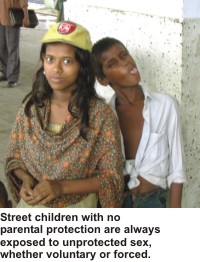 The
national blood transfusion programme, which has now over one
hundred-blood preservation and collection centres across the
country in various district hospitals and medical colleges,
unofficially says that screening for HIV infection shows about
0.02 per cent prevalence. The
national blood transfusion programme, which has now over one
hundred-blood preservation and collection centres across the
country in various district hospitals and medical colleges,
unofficially says that screening for HIV infection shows about
0.02 per cent prevalence.
All
these factors put together eerily resemble high HIV prevalence
countries in Africa such as South Africa, Kenya, Nigeria,
Mozambique and Zambia.
"The
fact remains that the Bangladesh government still believes
that HIV infection is low but what about the general population?"
asks an expert.
Many
countries require people to get mandatory testing for HIV
infection before travelling but those returning from countries
with high HIV prevalence have no arrangement for voluntary
couselling which is most urgently required in the present
scenario. There is evidence of high rates of HIV transmissions
to wives from their husbands after their return from mostly
Middle Eastern countries.
"We
must meet the challenge of expanding access to HIV treatment.
The government has no arrangements to provide treatment even
for opportunistic infection to people living with HIV/AIDS
(PLWHA) although we have more that 300 AIDS patients,"
says a physician of BSMMUH.
Low
Prevalence
According to the Joint United Nations Programme on HIV/AIDS
(UNAIDS), the first cases of HIV/AIDS, detected in Bangladesh
was the late 1980s and early 1990s, were among citizens returning
from foreign travel.
The
same UN agency reported, 13,000 people in Bangladesh were
living with HIV/AIDS at the end of 2001. Between 1989 and
1996, the Institute of Epidemiology, Disease Control, and
Research (IEDCR) tested 70,676 people from a variety of occupational
groups and found only 82 to be infected. Out of the total
67 were males, many who had lived abroad, and 15 females.
By
June 2002, the cumulative total of passively reported HIV
cases was 216, according to the Department of Virology of
Bangabandhu Sheikh Mujib Medical University (BSMMUH).
The
information on HIV prevalence in Bangladesh is limited and
available data suggests that the overall prevalence is low
even among vulnerable groups.
In
view of the gradual infection rate that started in the early
80s, the Bangladesh government formed a National AIDS Committee
way back in October 1985 for prevention and control of HIV/
AIDS. By 2003 it has completed a Short term Plan of Action,
an interim plan of Action and many other activities related
to prevention and control of HIV/AIDS.
The
National AIDS Committee, therefore, considered the necessity
for a national policy on HIV/AIDS. The Director General of
Health Services, accordingly, formed an 11-member "Task
Force" with the chairman of the Technical Committee as
its convenor.
GLOBAL
FACTS ON HIV/AIDS
Worldwide, AIDS kills more than 8,000 people every day or
one person every 10 seconds.
HIV accounts for the highest number of deaths by any single
infectious agent.
Since the beginning of the epidemic, AIDS has claimed more
than 25 million lives; more than 14 million children have
lost one or both parents to AIDS.
Every year, an estimated 3 million people die of AIDS of whom
500,000 are children under the age of 15 years.
Nearly 5 million persons (4.2 million adults and 700,000 children)
are newly infected with HIV each year; more than 95% of them
belong to developing countries.
Almost 50% of newly HIV-infected adults in 2003 were women
and 50% were young adults in the 1524 years age group.
Unsafe sex is the predominant mode of transmission of HIV
worldwide accounting for 8090% of infections.
There are 40 million persons living with HIV/AIDS, worldwide.
Of these, 2.5 million are children less than 15 years of age.
Six million people in developing countries have HIV infections
that urgently require antiretroviral treatment to keep them
alive and healthy but fewer than 300,000 are being treated.
General
Information on HIV/AIDS
What is HIV/AIDS?
HIV is the abbreviation of Human Immuno - deficiency Virus.
This virus caused Acquired Immuno Deficiency Syndrome (AIDS).
Thus HIV is the name of the virus and AIDS is the name of
the disease.
As the name AIDS implies, it is a condition where there is
deficiency in the body's natural defence mechanism or the
immune system. It is "acquired" because it is not
a hereditary condition.
It is important to note that every person who has HIV infection
will develop, AIDS over a period of time depending upon the
general health and natural defense mechanism of the body.
AIDS is caused by infection with the virus called Human Immunodeficiency
Virus (HIV). This virus is passed from one person to another
through blood-to-blood and sexual contact. In addition, infected
pregnant women can pass HIV to their babies during pregnancy
or delivery, as well as through breast-feeding. People with
HIV have what is called HIV infection. Most of these people
will develop AIDS as a result of their HIV infection.
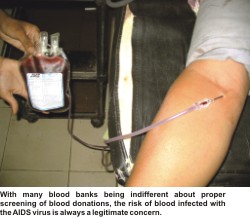 Basic
facts about HIV/AIDS Basic
facts about HIV/AIDS
What
body fluids transmit HIV?
These body fluids have been proven to spread HIV:
- blood
- semen
- vaginal fluid
- breast milk
- other body fluids containing blood
These
are additional body fluids that may transmit the virus that
health care workers may come into contact with:
fluid surrounding the brain and the spinal cord
fluid surrounding bone joints
fluid surrounding an unborn baby
The modes of HIV transmission
HIV
is transmitted mostly through semen and vaginal fluids during
unprotected sex without the use of condoms. Globally, most
cases of sexual transmission involve men and women, although,
in some developed countries homosexual activity remains the
primary mode.
Besides sexual intercourse, HIV can also be transmitted during
drug injection by the sharing of needles contaminated with
infected blood; by unsafe transfusion, of infected blood or
blood products; and from an infected woman to her baby - before
birth, during birth or just after delivery.
How
to avoid the virus?
One can avoid HIV infection by abstaining from sex, by having
a monogamous sexual relationship with an uninfected partner
or by practicing safer sex. Safer sex involves the correct
use of a condom during each sexual encounter and also includes
non-penetrative sex.
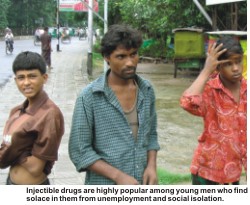 Is
oral sex unsafe? Is
oral sex unsafe?
Oral sex does carry some risk of infection because infected
fluids can be transmitted through the mouth especially if
there are bleeding gums or tiny sores somewhere in the mouth.
The same is true if infected sexual fluids from a woman get
into the mouth of her partner. But infection from oral sex
alone seems to be very rare.
Are
women at equal risk of being infected with HIV?
Women are, in fact, more at risk of getting infected because
of their increased vulnerability. In addition, their low status
within the family and society further heighten their vulnerability
to infection. It is therefore most important that every woman
has access to information about HIV/AIDS to protect herself.
How
does a mother transmit HIV to her unborn child?
An HIV-infected mother can infect her child in her womb during
constant exchange of her blood. The baby is more at risk if
the mother has been recently infected or is in a later stage
of AIDS. Transmission can also occur at the time of birth
when the baby is exposed to the mother's blood and to some
extent transmission can occur through breast milk. Transmission
from an infected mother to her baby occurs in about 30 per
cent of cases.
Is
there any risk of infection if one is physically exposed with
an HIV infected person?
There are no risks involved. One may share the same telephone
with other people in office or work side by side in a crowded
factory with other HIV infected persons, even share the same
cup of tea, but this will not expose one to the risk of contracting
the virus.
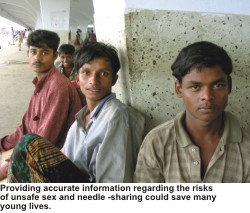 Can
someone get infected with HIV from mosquito bites? Can
someone get infected with HIV from mosquito bites?
No. From the start of the HIV epidemic there has been concern
about HIV transmission of the virus by biting and bloodsucking
insects, such as mosquitoes. However, studies conducted by
the Centre for Disease Control and Prevention in Atlanta,
USA (CDC) and elsewhere have shown no evidence of HIV transmission
through mosquito bites or any other insects even in areas
where there are many cases of AIDS and large populations of
mosquitoes. Lack of such outbreaks, despite intense efforts
to detect them, supports the conclusion that HIV is not transmitted
by insects.
It
is important to know that:
HIV is not an airborne or food-borne virus, and it does not
live long outside the body. HIV can be found in the blood,
semen, or vaginal fluid of an infected person.
The three main ways HIV is transmitted:
Through having sex (anal, vaginal, or oral) with someone infected
with HIV.
Through sharing needles and syringes with someone who has
HIV.
Through exposure (in the case of infants) to HIV before or
during birth, or through breast feeding.
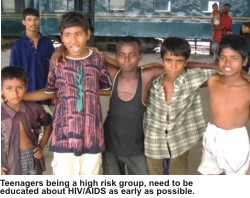 How
can one tell if he has HIV infection? How
can one tell if he has HIV infection?
The only way to know for sure if one has this virus is by
taking a blood test called the "HIV Antibody Test."
Some people call it the "HIV Test" or the "AIDS
Test," even though this test alone cannot tell if one
has AIDS. The HIV test can tell one if she has the virus and
can pass it to others in the ways already described.
What
are the symptoms of the HIV/AIDS?
A person infected with HIV is not likely to have any symptoms
for about three to ten years. This period may be longer if
the natural defense mechanism of the body is good. Although
a person infected with HIV does not have any symptoms, he/she
can spread the infection to others.
The symptoms of AIDS are divided into major and minor symptoms.
As per the definition of AIDS given by the World Health Organisation,
a person is said to have AIDS if he/she at least two major
signs and at least one minor sign and there is no other cause
of poor immune mechanism. The term "AIDS related illness"
is used when a person has some of the signs and symptoms,
has antibodies to HIV in the blood but does not have two major
and one minor sign.
Interview
Living
With the AIDS virus
NAIMUL
HAQ speaks to the executive director of Ashar Alo Habiba Akter
about the existing problems of People Living with HIV/AIDS
(PLWHA)
"Treatment
management for the people living with HIV/AIDS (PLWHA) is
a major concern now and unfortunately the state or private
sector provides no support in this regard to any PLWHA,"
Says Habiba Akter, founder executive director of Ashar Alo,
an organisation of PLWHA. "Many people are suffering
from opportunistic infections who badly require care and support
and most importantly hospitalisation but the public or private
hospital do not want to treat us," continues Akter.
Akter,
who has had wide range of exposure on travelling to various
countries to be trained on HIV/AIDS adds, "Nineteen out
of a total of 108 members of our organisation died in the
last two years. I am sure that if we were able to provide
appropriate support to them they could have lived longer.
Although we are getting support from organisations like Family
Health International, Christian Commission for Development
in Bangladesh (CCDB) and Action Aid it is still not enough.
We need more support for example to buy anti-retroviral (ARV),
to conduct regular testing for CD4 cells and viral load test,
both of which are vital for a PLWHA but currently these are
being done from our own organisation with great limitations."
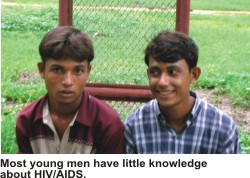 "Last
December one of our members in Sylhet had to be shifted to
the capital for hospitalisation. He had no support for care
and treatment but he died on the train on his way to the capital.
This is sad that despite knowing about our problems the government
has done, until now, nothing to come to our support." "Last
December one of our members in Sylhet had to be shifted to
the capital for hospitalisation. He had no support for care
and treatment but he died on the train on his way to the capital.
This is sad that despite knowing about our problems the government
has done, until now, nothing to come to our support."
Akter
also explained that private medical practitioners do not want
to treat PLWHA. So there is not much choice except for referring
a sick PLWHA to our designated hospital for treatment. Akter
also observed that donors and many private organisations have
contributed for many social development activities but they
are not interested in supporting PLWHA. "We badly require
financial support to help our members to make a healthy living
but due to lack of funds we are unable to do that," Akter
said.
Ashar
Alo, established in 2000, has been actively engaged in counselling
on HIV/AIDS especially to family members of PLWHA, medical
practitioners, community leaders and PLWHA themselves.
She
also talked about discrimination of PLWHA saying that the
way awareness raising programmes are being carried out is
not enough. Innovative and more attractive programmes are
needed to raise awareness about HIV/AIDS and for this the
media must come forward. At the same time the programmes must
focus on avoiding discriminating PLWHA which is a major problem
in Bangladesh.
Ashar
Alo plans to expand in Rajshahi and Khulna this year. It already
has branches in Sylhet and Chittagong.
Naimul
Haq, senior reporter of The Daily Star, has had wide experience
on HIV/AIDS attending special training programmes, workshops,
and conferences and has been awarded several prestigious fellowships
abroad.
Copyright
(R) thedailystar.net 2004
| 